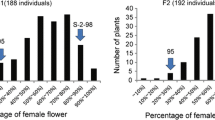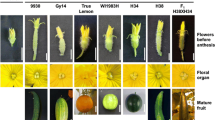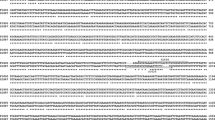Abstract
Cucumber is a typical monoecious having separate male and female flowers on the same plant, and sex expression in cucumber is mainly determined by three major genes: F/f, M/m and A/a. Gynoecy plays an important role in cucumber hybrid breeding, and the use of gynoecious lines as maternal parents ensures high productivity. This study aimed to identify a co-dominant marker linked to Female (F) locus to distinguish homozygous and heterozygous gynoecious lines for efficient selection of gynoecy in cucumber breeding. Firstly, we analyzed a 50-kb genomic sequence of five gynoecious and five monoecious inbred lines to detect the polymorphism linked to F locus. A pair of specific primers, Cs-BCAT-F/Cs-BCAT-R, based on an In/Del polymorphism at 3′-UTR of branched-chain amino acid transaminase (BCAT) gene was designed to examine the polymorphism in gynoecious and monoecious parents, their F 1 hybrids and two F 2 segregating populations. The PCR fragments amplified with Cs-BCAT-F/Cs-BCAT-R co-segregated with sexual phenotypes in the F 2 populations, behaving as a co-dominant marker with two alleles: F (gynoecious) and f (monoecious). When we further verified the consistency of the co-dominant marker using additional 55 diverse inbred lines, it can explain ~90 % of accessions. Linkage analysis also showed that the gene which enhances the number of female flowers co-segregated with the co-dominant marker on the long arm of chromosome 6. This is the first report for the development of F locus-specific co-dominant marker which can distinguish perfectly homozygous and heterozygous gynoecious, and it could be used in marker-assisted selection in cucumber breeding.




Similar content being viewed by others
References
Allard RW (1956) Formulas and tables to facilitate the calculation of recombination values in heredity. Hilgardia 24:235–278
Bu F, Chen H, Shi Q, Zhou Q, Gao D, Zhang Z, Huang S (2015) A major quantitative trait locus conferring subgynoecy in cucumber. Theor Appl Genet. doi:10.1007/s00122-015-2612-z
Chen H, Tian Y, Lu X, Liu X (2011) The inheritance of two novel subgynoecious genes in cucumber (Cucumis sativus L.). Sci Hortic (Amsterdam) 127:464–467
Dellaporta SL, Wood J, Hicks JB (1983) A plant DNA minipreparation: Version II. Plant Mol Biol Rep 1:19–21
Diebold R, Schuster J, Daschner K, Binder S (2002) The branched-chain amino acid transaminase gene family in Arabidopsis encodes plastid and mitochondrial proteins. Plant Physiol 129:540–550
Fazio G, Staub JE, Chung SM (2002) Development and characterization of PCR markers in cucumber. J Am Soc Hortic Sci 127(4):545–557
Huang S, Li R, Zhang Z, Li L, Gu X, Fan W, Lucas WJ, Wang X, Xie B, Ni P (2009) The genome of the cucumber, Cucumis sativus L. Nat Genet 41:1275–1281
Knopf RR, Trebitsh T (2006) The female-specific CsACS1G gene of cucumber. A case of gene duplication and recombination between the non-sex-specific 1-aminocyclopropane-1-carboxylate synthase gene and a branched chain amino acid transaminase gene. Plant Cell Physiol 47(9):1217–1228
Kosambi D (1944) The estimation of map distance from recombination values. Ann Eugen 12:172–175
Kubicki B (1969) Investigation on sex determination in cucumber (Cucumis sativus L.). Genet Pol 10:69–86
Lander ES, Green P, Abrahamson J, Barlow A, Daly MJ, Lincoln SE, Newburg L (1987) MAPMAKER: an interactive computer package for constructing primary genetic linkage maps of experimental and natural populations. Genomics 1:178–181
Langmead B, Salzberg SL (2012) Fast gapped-read alignment with Bowtie 2. Nat Methods 9:357–359
Less H, Galili G (2008) Principal transcriptional programs regulating plant amino acid metabolism in response to abiotic stresses. Plant Physiol 147:316–330
Malepszy S, Niemirowicz-Szczytt K (1991) Sex determination in cucumber (Cucumis sativus) as a model system for molecular biology. Plant Sci 80:39–47
Mibus H, Tatlioglu T (2004) Molecular characterization and isolation of the F/f gene for femaleness in cucumber (Cucumis sativus L.). Theor Appl Genet 109:1669–1676
Perl-Treves R (1999) In sex determination in plants. In: Ainsworth C (ed) Male to female conversion along the cucumber shoot: approaches to studying sex genes and floral development in Cucumis sativus. Blackwell, London, pp 189–216
Perl-Treves R, Rajagopalan PA (2006) Annual plant reviews volume 20: flowering and its manipulation. In: Ainsworth C (ed) Close, yet separate: patterns of male and female floral development in monoecious species. Blackwell, London, pp 117–146. doi:10.1002/9780470988602.ch6
Pommerrenig B, Feussner K, Zierer W, Rabinovych V, Klebl F, Feussner I, Sauer N (2011) Phloem-specific expression of Yang cycle genes and identification of novel Yang cycle enzymes in Plantago and Arabidopsis. Plant Cell 23:1904–1919
Ren Y, Zhang Z, Liu J, Staub JE, Han Y, Cheng Z (2009) An integrated genetic and cytogenetic map of the cucumber genome. PLoS One 4(6):e5795. doi:10.1371/journal.pone.0005795
Schuster J, Binder S (2005) The mitochondrial branched-chain aminotransferase (AtBCAT-1) is capable to initiate degradation of leucine, isoleucine and valine in almost all tissues in Arabidopsis thaliana. Plant Mol Biol 57:241–254
Shifriss O (1961) Sex control in cucumbers. J Hered 51:5–12
Trebitsh T, Staub JE, O’Neill SD (1997) Identification of a 1-aminocyclopropane-1-carboxylic acid synthase gene linked to the Female (F) locus that enhances female sex expression in cucumber. Plant Physiol 113:987–995
Woycicki R, Witkowicz J, Gawronski P, Dabrowska J, Lomsadze A (2011) The genome sequence of the North-European cucumber (Cucumis sativus L.) unravels evolutionary adaptation mechanisms in plants. PLoS One 6(7):e22728
Wu T, Qin Z, Feng Z, Zhou X, Xin M, Du Y (2012) Functional analysis of the promoter of a female specific cucumber CsACS1G gene. Plant Mol Biol Rep 30:235–241. doi:10.1007/s11105-011-0318-1
Yan L (2012) Effect and regulation of ethylene in the biosynthesis of aroma volatiles in oriental sweet melon (Cucumis melo var. Maruwa Makino). Shenyang Agricultural University, China
Yang XT, Song J, Fillmore S, Pang XQ, Zhang ZQ (2011) Effect of high temperature on color, chlorophyll fluorescence and volatile biosynthesis in green-ripe banana fruit. Postharvest Biol Technol 62:246–257
Zhang Z, Mao L, Chen H et al (2015) Genome-wide mapping of structural variations reveals a copy number variant that determines reproductive morphology in cucumber. Plant Cell. doi:10.1105/tpc.114.135848
Zhou S, Zhang P, Zhu Y, Chen X, Chen L (2013) Identification of SSR marker linked to gynoecious loci in cucumber (Cucumis sativus L.). J Zhejiang Univ Agric Life Sci 39(3):291–298. doi:10.3785/j.issn.1008-9209.2012.11.141
Acknowledgments
This work was supported by Grants from Bio-industry Technology Development Program (111057-5) of iPET (Korea Institute of Planning and Evaluation for Technology in Food, Agriculture and Forestry).
Author information
Authors and Affiliations
Corresponding author
Electronic supplementary material
Below is the link to the electronic supplementary material.
Rights and permissions
About this article
Cite this article
Win, K.T., Zhang, C., Song, K. et al. Development and characterization of a co-dominant molecular marker via sequence analysis of a genomic region containing the Female (F) locus in cucumber (Cucumis sativus L.). Mol Breeding 35, 229 (2015). https://doi.org/10.1007/s11032-015-0424-0
Received:
Accepted:
Published:
DOI: https://doi.org/10.1007/s11032-015-0424-0




